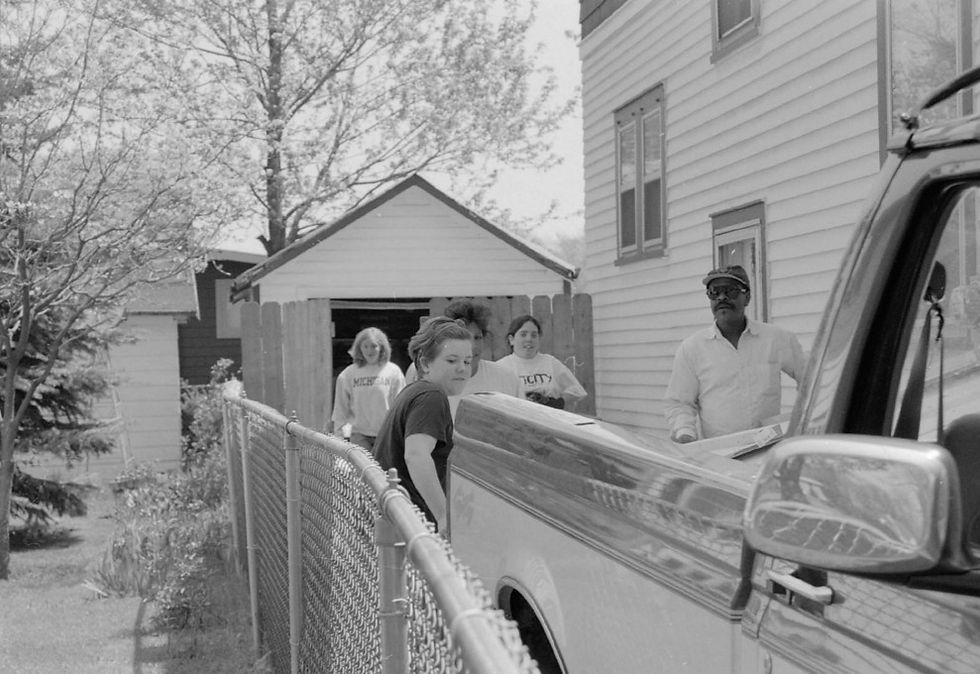
HISTORY
THE HISTORY OF BUILDING BLOCKS
written by: DR. KIM CUMMINGS, Founder
Building Blocks began as a tiny pilot project in the spring of 1995, aiming to help the associations representing Kalamazoo’s low-income neighborhoods to extend their organizing efforts to individual streets. It had a lot to prove: that college/university students had sufficient commitment and awareness to serve effectively as project organizers, that residents had sufficient energy, skill, and receptivity to nearby neighbors to collectively carry out the home improvement projects, and that cooperative work could jump-start the re-building of community ties on streets where people had fallen out of touch with one another.
The Eastside Neighborhood Association, under the leadership of its newly appointed director Sam Leolofi, bravely sponsored one pilot. The Vine Neighborhood Association, headed by Sean McCann, sponsored the other. In each case, the target sites selected by the neighborhoods were small, made up of a couple of individual streets. The three students, given orientation to their task by Sociology professor Kim Cummings, canvassed their sites to identify interested residents and assumed primary responsibility for facilitating resident meetings. The participating neighborhood associations supported the students in their work, particularly in the workdays themselves. Not everything went smoothly that first year, but the most important lessons were positive:
-
Residents loved the program and were ready to help each other with the work, to help feed each other during workdays, and to form lasting relationships with one another.
-
Neighborhood associations were ready to assume responsibility for the projects on the “ground level” and were excited by the project’s success in improving the looks of individual streets, building community among residents, and winning the loyalties of residents to their associations; and
-
Students were energized by the challenges associated with helping to organize residents in a complex project, experiencing gains in personal maturity, civic involvement, communication skills, and social awareness.
The enthusiasm generated by the two pilot projects fueled an expansion of the project to four sites in the spring of 1996: one on the Eastside, two in Vine, and one in Stuart. The second year’s project also marked the beginning of Professor Cummings’ community organizing class, the members of which, in teams of three, served as target-site organizers. Meeting regularly in class, the students received much more adequate preparation for their task and, this being a credit-bearing activity, could afford to give much more of their time to the fieldwork itself.
From the beginning, Building Blocks operated not as a conventional grant-giving entity but as a “collaborative,” with those entities with most at stake—the neighborhood associations and the higher-education institution providing the student organizers (initially Kalamazoo College)—sharing the burdens of responsibility as board members and laboring together to shape the project itself. Two other entities with a stake in neighborhood revitalization—Kalamazoo Neighborhood Housing Services (which also functioned as fiduciary agent) and the Local Initiative Support Corporation (which provided fund-raising expertise and other technical assistance)—also were represented on the board. The principle of shared collaborative responsibility, which has remained consistent through the present time, enabled Building Blocks to operate without a paid executive director; the board members themselves carried out most administrative functions. From its inception, therefore, at both the level of the street projects and its governing board, Building Blocks has operated on the principle of self-help, substituting voluntary contributions for paid help.
Building Blocks extended its community-building activities to the Edison, West Douglas Neighborhood, Oakwood, and Northside neighborhoods in subsequent years, expanding to eleven sites located in seven neighborhoods, and staffed by 30 student organizers in 2000. After six years of operating under the Kalamazoo Neighborhood Housing Services “umbrella,” Building Blocks evolved toward independence, gaining corporate status from the State of Michigan and winning non-profit recognition from the Internal Revenue Service in 2003. Upon Professor Cummings’ retirement from Kalamazoo College in 2010, his course was adopted by Western Michigan University’s School of Social Work. Additional support for the course has come from the Sociology and Political Science Departments, the Non-Profit Leadership Program, and the Walker Institute sponsored minor in Race and Ethnic Relations.
Building Blocks has enjoyed remarkable loyalty from generous local funders, prominently including the Kalamazoo Community Foundation, the Irving S. Gilmore Foundation, the Fetzer Foundation, the Local Initiatives Support Corporation, and more recently the Harold and Grace Upjohn Foundation, the First Presbyterian Church, and the Moses Kimball Fund of Boston, Massachusetts. Other local churches, banks, and foundations also have contributed generously. The City of Kalamazoo has provided crucial “in-kind” assistance by picking up and disposing of the trash generated by our project activities, and local retailers have donated an immense amount of food for hungry volunteer workers.
Although Building Blocks operates in distinctively small sites, the cumulative effect of its activities is impressive. Over 22 years the program has enabled over1,600 households in the city’s low- and low-to-moderate neighborhoods to upgrade their homes when few other discretionary funds were available. Of more lasting but less measurable importance, Building Blocks has helped to regenerate community ties in 134 street-level target sites, supporting improvements in general quality of life as neighbors step forward to take collective responsibility. Neighborhood associations also have benefited from the influx of new leaders and new loyalties from local residents.



Building blocks for over 20 years!